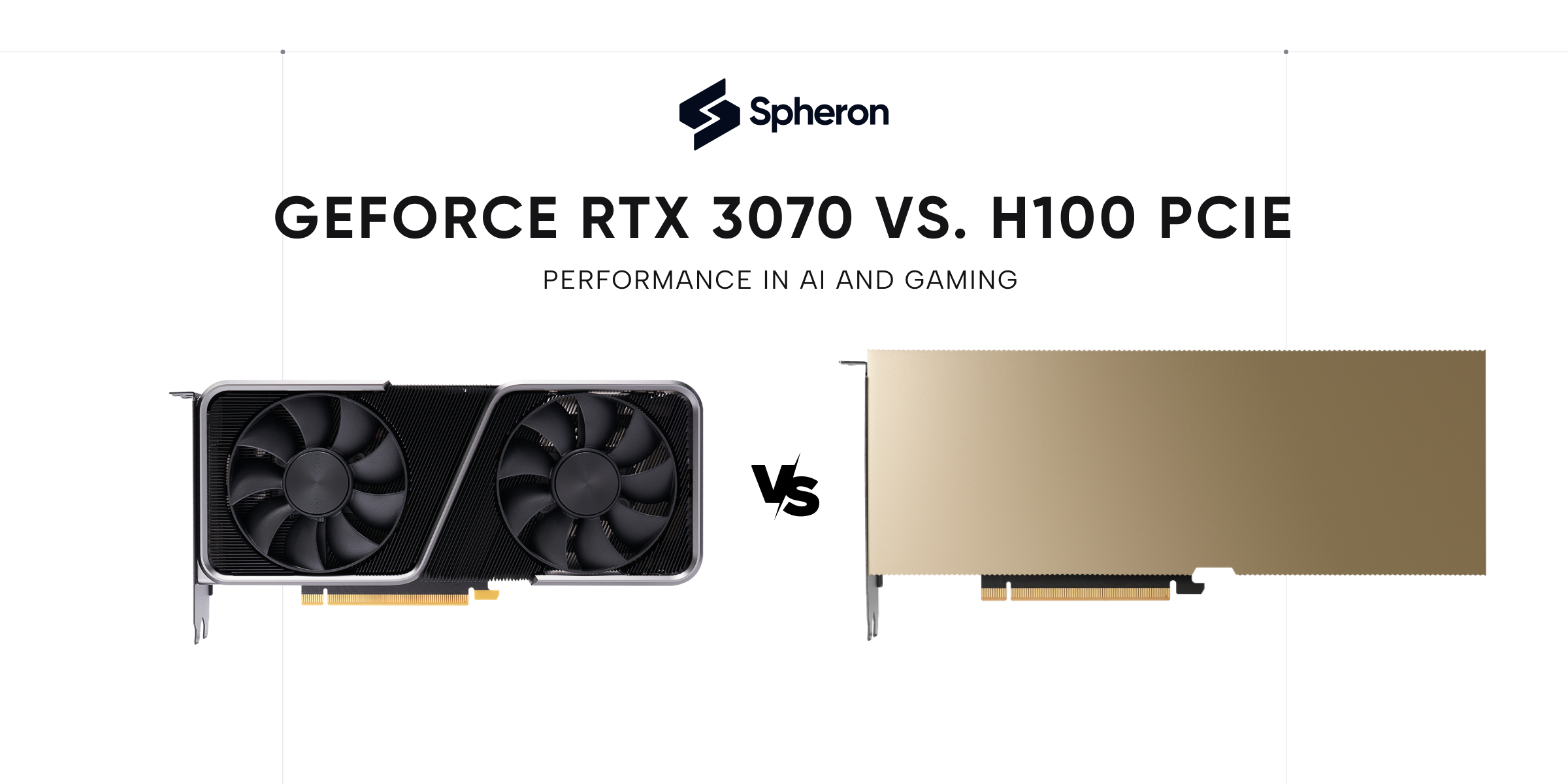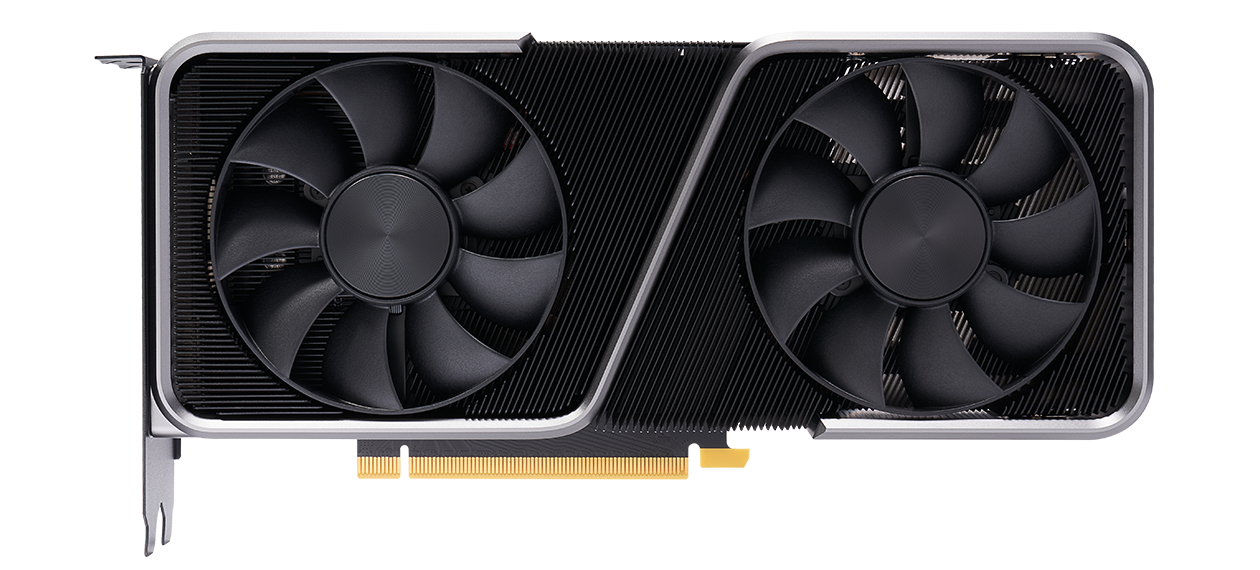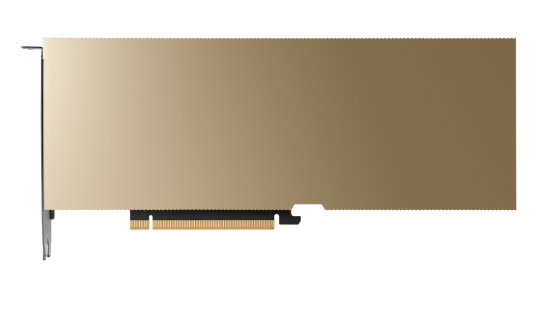GeForce RTX 3070 vs. H100 PCIe: Performance in AI and Gaming
 Spheron Network
Spheron NetworkTable of contents
- Understanding the GeForce RTX 3070
- Understanding the H100 PCIe
- Core Differences Between GeForce RTX 3070 and H100 PCIe
- Performance in Gaming
- AI and Machine Learning Performance
- Power Efficiency and Thermal Performance
- Price and Value for Money
- Use Case Scenarios: Who Should Buy What?
- Future-Proofing and Software Support
- Conclusion
- FAQs

In high-performance computing, the role of GPUs (Graphics Processing Units) has never been more crucial. Whether diving into the latest AAA gaming titles or training sophisticated AI models, the proper GPU can make all the difference. Among the most talked-about GPUs are NVIDIA’s GeForce RTX 3070 and the H100 PCIe. But how do they stack up against each other in AI and gaming? This article compares these two powerful GPUs comprehensively to help you understand their strengths, weaknesses, and best use cases.
Understanding the GeForce RTX 3070

Launched in late 2020, the GeForce RTX 3070 is part of NVIDIA’s Ampere architecture, designed primarily for gamers and content creators. It boasts impressive specs, including 5888 CUDA cores, 8GB of GDDR6 memory, and a boost clock of up to 1.73 GHz. The RTX 3070 delivers robust gaming performance at a competitive price point, making it a popular choice for those who want high-quality graphics without breaking the bank.
Understanding the H100 PCIe

The H100 PCIe, part of NVIDIA’s Hopper architecture, is engineered specifically for data centers and AI applications. Unlike the RTX 3070, the H100 is not a consumer-grade GPU but a powerhouse for complex computational tasks. It features thousands of CUDA and Tensor cores designed to handle the intense workload of AI training, deep learning, and data processing. With enhanced memory capacity and bandwidth, the H100 sets a new benchmark in AI performance.
Here's a comparison chart between the GeForce RTX 3070 and the NVIDIA H100 PCIe GPU:
| Feature | GeForce RTX 3070 | NVIDIA H100 PCIe |
| Architecture | Ampere | Hopper |
| Release Date | October 2020 | March 2023 |
| CUDA Cores | 5,888 | 16,896 |
| Tensor Cores | 184 | 528 |
| Ray Tracing Cores | 46 | N/A (Focused on AI and HPC) |
| Base Clock Speed | 1.50 GHz | 1.95 GHz |
| Boost Clock Speed | 1.73 GHz | 2.60 GHz |
| Memory Size | 8 GB GDDR6 | 80 GB HBM2e |
| Memory Bandwidth | 448 GB/s | 2,000 GB/s |
| Power Consumption (TDP) | 220W | 350W |
| Interface | PCIe 4.0 x16 | PCIe 5.0 x16 |
| FP32 Performance | 20.3 TFLOPS | 60 TFLOPS |
| AI Performance (Tensor) | ~162.5 TFLOPS | ~4,000 TFLOPS |
| Ray Tracing Performance | 39.7 RT-TFLOPS | N/A |
| VRAM Type | GDDR6 | HBM2e |
| Target Audience | Gamers, Content Creators | AI Researchers, Data Scientists, HPC |
| Use Cases | Gaming, Streaming, VR | AI Training/Inference, Data Analytics |
| Price Range | $499 - $599 (Retail) | $10,000 - $15,000 |
Core Differences Between GeForce RTX 3070 and H100 PCIe
The primary difference between the RTX 3070 and H100 PCIe is their architecture. The RTX 3070’s Ampere architecture is optimized for gaming, with dedicated ray-tracing cores and DLSS (Deep Learning Super Sampling) technology that enhances gaming visuals. In contrast, the H100's Hopper architecture focuses on AI acceleration, offering unmatched Tensor core performance and memory bandwidth, which are essential for AI model training.
CUDA and Tensor Cores: The RTX 3070 comes with 5888 CUDA cores and 184 Tensor cores, while the H100 boasts tens of thousands of CUDA cores with a much higher number of Tensor cores, optimized specifically for deep learning tasks.
Memory Bandwidth: The RTX 3070 offers 448 GB/s of bandwidth, whereas the H100 PCIe exceeds this significantly, providing over 2 TB/s, allowing it to handle massive data loads efficiently.
Performance in Gaming
When it comes to gaming, the RTX 3070 excels. With real-time ray tracing and DLSS capabilities, it delivers smooth frame rates at high resolutions, even in the most demanding games. Benchmarks often show the RTX 3070 achieving over 60 FPS in 1440p and 4K settings in games like Cyberpunk 2077 and Assassin’s Creed Valhalla. Its power efficiency and cooling capabilities also ensure a consistent gaming experience without significant throttling.
The H100 PCIe is not designed for gaming, but its powerful computational cores allow it to run games at basic settings. However, without optimizations like ray tracing and DLSS, the gaming experience falls short compared to the RTX 3070. Its architecture prioritizes AI computations over graphical fidelity, making it an impractical choice for gamers.
AI and Machine Learning Performance
While the RTX 3070 is primarily a gaming GPU, it still packs some serious AI capabilities thanks to its Tensor cores. It handles smaller-scale AI tasks like model inference and training with ease, making it a great entry-level option for AI enthusiasts. However, it falls short when dealing with large datasets or complex neural networks, where its memory capacity and bandwidth become limiting factors.
The H100 PCIe shines in AI and machine learning environments. Its Hopper architecture is specifically designed to accelerate AI workflows, from training massive models to running advanced simulations. The H100 supports mixed-precision calculations, significantly speeding up deep learning tasks without compromising accuracy. This makes it the go-to GPU for AI researchers and data scientists working on cutting-edge projects.
Power Efficiency and Thermal Performance
Power efficiency is crucial, especially in high-performance tasks. The RTX 3070 typically consumes around 220 watts under full load, while the H100 PCIe can consume significantly more due to its higher computational power. Thermal management is more critical for the H100, requiring robust cooling solutions often found in data centers rather than home setups.
Price and Value for Money
The RTX 3070 is a cost-effective option for gamers, priced around $500–$600, depending on the market. The H100 PCIe, however, is significantly more expensive, often costing thousands of dollars due to its specialized components and capabilities. For gaming, the RTX 3070 offers the best bang for your buck, while the H100 PCIe’s value is realized only in professional AI environments.
Use Case Scenarios: Who Should Buy What?
For Gamers: The RTX 3070 is a clear choice, offering superior gaming performance at a reasonable price.
For AI Researchers: The H100 PCIe is unparalleled in AI performance, making it the best choice for those working in machine learning and deep learning.
Mixed-Use Scenarios: If your work involves both gaming and AI, the RTX 3070 can handle basic AI tasks, but the H100 PCIe is overkill for gaming.
Future-Proofing and Software Support
Both GPUs are well-supported by NVIDIA’s software ecosystem, but the H100 PCIe benefits from additional support for AI frameworks and data center optimizations. Future driver updates will continue to enhance their respective performance, but the H100’s updates will likely focus more on AI improvements.
The RTX 3070 enjoys a large user community, with extensive guides, mods, and third-party software to enhance gaming experiences. The H100 PCIe’s support is more niche, geared toward professionals with access to specialized AI development tools.
Conclusion
Choosing between the GeForce RTX 3070 and the H100 PCIe depends entirely on your needs. For gaming, the RTX 3070 stands out with its excellent performance, affordability, and gaming-specific optimizations. On the other hand, the H100 PCIe is a top-tier AI GPU designed for those who require the absolute best in AI and machine learning capabilities. While they both carry the NVIDIA name, their target markets and strengths are worlds apart.
FAQs
Which GPU is better for gaming, the RTX 3070 or H100 PCIe?
The RTX 3070 is far superior due to its gaming-focused architecture, including ray tracing and DLSS technologies.
Can the H100 PCIe be used for gaming?
Yes, but it’s not optimized for gaming and lacks the visual enhancements of gaming GPUs like the RTX 3070.
How does power consumption differ between the RTX 3070 and H100 PCIe? The H100 PCIe consumes significantly more power due to its advanced AI capabilities, making it less efficient for general use than the RTX 3070.
Are there any AI-specific features in the RTX 3070?
Yes, the RTX 3070 has Tensor cores that enhance AI-related tasks, but they are not as powerful as those in the H100 PCIe.
What is the best use case for the H100 PCIe?
It is best suited for AI research, data science, and other professional workloads that require massive computational power.
Subscribe to my newsletter
Read articles from Spheron Network directly inside your inbox. Subscribe to the newsletter, and don't miss out.
Written by

Spheron Network
Spheron Network
On-demand DePIN for GPU Compute